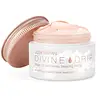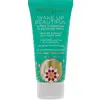What's inside
What's inside
 Key Ingredients
Key Ingredients

 Benefits
Benefits

 Concerns
Concerns

 Ingredients Side-by-side
Ingredients Side-by-side

Water
Skin ConditioningIsopropyl Palmitate
EmollientCaprylic/Capric Triglyceride
MaskingCetearyl Alcohol
EmollientGlyceryl Stearate
EmollientCocoglycerides
EmollientCocos Nucifera Oil
MaskingGlycerin
HumectantBiosaccharide Gum-4
Skin ConditioningPyrus Malus Fruit Extract
Skin ConditioningLauryl Laurate
Skin ConditioningPropylheptyl Caprylate
EmollientMyristyl Myristate
EmollientArgania Spinosa Extract
Skin ConditioningBentonite
AbsorbentHoney
HumectantTheobroma Cacao Seed Butter
EmollientButyrospermum Parkii Butter
Skin ConditioningHelianthus Annuus Seed Oil
EmollientAlgin
MaskingAloe Barbadensis Leaf Juice
Skin ConditioningAlpha-Glucan Oligosaccharide
CleansingArgania Spinosa Kernel Oil
EmollientPollen Extract
EmollientBehenyl Alcohol
EmollientBiosaccharide Gum-1
HumectantCitric Acid
BufferingCopernicia Cerifera Wax
Ethylhexylglycerin
Skin ConditioningHelianthus Annuus Seed Extract
Skin ConditioningHoney Extract
HumectantHydrogenated Ethylhexyl Olivate
EmollientHydrogenated Olive Oil Unsaponifiables
EmollientHydrolyzed Hyaluronic Acid
HumectantLecithin
EmollientMacadamia Ternifolia Seed Oil
EmollientMangifera Indica Seed Butter
Skin ConditioningMica
Cosmetic ColorantOlea Europaea Fruit Oil
MaskingPanthenol
Skin ConditioningPersea Gratissima Oil
Skin ConditioningPhenoxyethanol
PreservativePolyglyceryl-3 Diisostearate
EmulsifyingPropanediol
SolventPropolis Extract
Skin ConditioningRosmarinus Officinalis Leaf Extract
AntimicrobialRoyal Jelly Extract
Skin ConditioningSilica
AbrasiveSodium Stearoyl Glutamate
CleansingCI 77891
Cosmetic ColorantTocopherol
AntioxidantVitis Vinifera Seed Oil
EmollientXanthan Gum
EmulsifyingLonicera Caprifolium Flower Extract
PerfumingLonicera Japonica Flower Extract
Skin ConditioningPotassium Sorbate
PreservativeSodium Benzoate
MaskingCI 15985
Cosmetic ColorantCI 14700
Cosmetic ColorantCalcium Aluminum Borosilicate
Water, Isopropyl Palmitate, Caprylic/Capric Triglyceride, Cetearyl Alcohol, Glyceryl Stearate, Cocoglycerides, Cocos Nucifera Oil, Glycerin, Biosaccharide Gum-4, Pyrus Malus Fruit Extract, Lauryl Laurate, Propylheptyl Caprylate, Myristyl Myristate, Argania Spinosa Extract, Bentonite, Honey, Theobroma Cacao Seed Butter, Butyrospermum Parkii Butter, Helianthus Annuus Seed Oil, Algin, Aloe Barbadensis Leaf Juice, Alpha-Glucan Oligosaccharide, Argania Spinosa Kernel Oil, Pollen Extract, Behenyl Alcohol, Biosaccharide Gum-1, Citric Acid, Copernicia Cerifera Wax, Ethylhexylglycerin, Helianthus Annuus Seed Extract, Honey Extract, Hydrogenated Ethylhexyl Olivate, Hydrogenated Olive Oil Unsaponifiables, Hydrolyzed Hyaluronic Acid, Lecithin, Macadamia Ternifolia Seed Oil, Mangifera Indica Seed Butter, Mica, Olea Europaea Fruit Oil, Panthenol, Persea Gratissima Oil, Phenoxyethanol, Polyglyceryl-3 Diisostearate, Propanediol, Propolis Extract, Rosmarinus Officinalis Leaf Extract, Royal Jelly Extract, Silica, Sodium Stearoyl Glutamate, CI 77891, Tocopherol, Vitis Vinifera Seed Oil, Xanthan Gum, Lonicera Caprifolium Flower Extract, Lonicera Japonica Flower Extract, Potassium Sorbate, Sodium Benzoate, CI 15985, CI 14700, Calcium Aluminum Borosilicate
Water
Skin ConditioningCaprylic/Capric Triglyceride
MaskingHelianthus Annuus Flower
Skin ConditioningGlycerin
HumectantGlyceryl Stearate
EmollientStearic Acid
CleansingAloe Barbadensis Leaf Juice
Skin ConditioningButyrospermum Parkii Butter
Skin ConditioningXanthan Gum
EmulsifyingPersea Gratissima Oil
Skin ConditioningRosa Centifolia Flower Extract
AstringentJasminum Officinale Flower Water
MaskingPanthenol
Skin ConditioningAllantoin
Skin ConditioningTocopherol
AntioxidantHydrolyzed Rice Protein
Skin ConditioningOryza Sativa Bran Oil
EmollientHyaluronic Acid
HumectantGanoderma Lucidum Stem Extract
Skin ConditioningLentinus Edodes Extract
Skin ConditioningCalendula Officinalis Flower Extract
MaskingPhenoxyethanol
PreservativeEthylhexylglycerin
Skin ConditioningChamomilla Recutita Flower Extract
MaskingParfum
MaskingWater, Caprylic/Capric Triglyceride, Helianthus Annuus Flower, Glycerin, Glyceryl Stearate, Stearic Acid, Aloe Barbadensis Leaf Juice, Butyrospermum Parkii Butter, Xanthan Gum, Persea Gratissima Oil, Rosa Centifolia Flower Extract, Jasminum Officinale Flower Water, Panthenol, Allantoin, Tocopherol, Hydrolyzed Rice Protein, Oryza Sativa Bran Oil, Hyaluronic Acid, Ganoderma Lucidum Stem Extract, Lentinus Edodes Extract, Calendula Officinalis Flower Extract, Phenoxyethanol, Ethylhexylglycerin, Chamomilla Recutita Flower Extract, Parfum
Ingredients Explained
These ingredients are found in both products.
Ingredients higher up in an ingredient list are typically present in a larger amount.
Aloe Barbadensis Leaf Juice comes from leaves of the aloe plant. Aloe Barbadensis Leaf Juice is best known for helping to soothe sunburns. It is also anti-inflammatory, moisturizing, antiseptic, and can help heal wounds.
Aloe is packed with good stuff including Vitamins A, C, and E. These vitamins are antioxidants, which help fight free-radicals and the damage they may cause. Free-radicals are molecules that may damage your skin cells, such as pollution.
Aloe Barbadensis Leaf Juice also contains sugars. These sugars come in the form of monosaccharides and polysaccharides, folic acid, and choline. These sugars are able to help bind moisture to skin.
It also contains minerals such as calcium, 12 anthraquinones, fatty acids, amino acids, and Vitamin B12.
Learn more about Aloe Barbadensis Leaf JuiceThis ingredient is also known as shea butter. It is an effective skin hydrator and emollient.
Emollients help soothe and soften your skin. It does this by creating a protective film on your skin. This barrier helps trap moisture and keeps your skin hydrated. Emollients may be effective at treating dry or itchy skin.
Shea butter is rich in antioxidants. Antioxidants help fight free-radicals, or molecules that may harm the body. It is also full of fatty acids including stearic acid and linoleic acid. These acids help replenish the skin and keep skin moisturized.
While Shea Butter has an SPF rating of about 3-4, it is not a sunscreen replacement.
Shea butter may not be fungal acne safe. We recommend speaking with a professional if you have any concerns.
Learn more about Butyrospermum Parkii ButterThis ingredient is an emollient, solvent, and texture enhancer. It is considered a skin-softener by helping the skin prevent moisture loss.
It helps thicken a product's formula and makes it easier to spread by dissolving clumping compounds.
Caprylic Triglyceride is made by combining glycerin with coconut oil, forming a clear liquid.
While there is an assumption Caprylic Triglyceride can clog pores due to it being derived from coconut oil, there is no research supporting this.
Learn more about Caprylic/Capric TriglycerideEthylhexylglycerin (we can't pronounce this either) is commonly used as a preservative and skin softener. It is derived from glyceryl.
You might see Ethylhexylglycerin often paired with other preservatives such as phenoxyethanol. Ethylhexylglycerin has been found to increase the effectiveness of these other preservatives.
Glycerin is already naturally found in your skin. It helps moisturize and protect your skin.
A study from 2016 found glycerin to be more effective as a humectant than AHAs and hyaluronic acid.
As a humectant, it helps the skin stay hydrated by pulling moisture to your skin. The low molecular weight of glycerin allows it to pull moisture into the deeper layers of your skin.
Hydrated skin improves your skin barrier; Your skin barrier helps protect against irritants and bacteria.
Glycerin has also been found to have antimicrobial and antiviral properties. Due to these properties, glycerin is often used in wound and burn treatments.
In cosmetics, glycerin is usually derived from plants such as soybean or palm. However, it can also be sourced from animals, such as tallow or animal fat.
This ingredient is organic, colorless, odorless, and non-toxic.
Glycerin is the name for this ingredient in American English. British English uses Glycerol/Glycerine.
Learn more about GlycerinGlyceryl Stearate is a mix of glycerin and stearic acid.
It is used to stabilize the mixing of water and oil ingredients. By preventing these ingredients from separating, it can help elongate shelf life. It can also help thicken the product's texture.
As an emollient, it helps soften skin and supports barrier-replenishing ingredients.
In cosmetics, Glyceryl Stearate is often made from vegetable oils or synthetically produced.
This ingredient may not be fungal-acne safe
Fun fact: The human body also creates Glyceryl Stearate naturally.
Learn more about Glyceryl StearatePanthenol is a common ingredient that helps hydrate and soothe the skin. It is found naturally in our skin and hair.
There are two forms of panthenol: D and L.
D-panthenol is also known as dexpanthenol. Most cosmetics use dexpanthenol or a mixture of D and L-panthenol.
Panthenol is famous due to its ability to go deeper into the skin's layers. Using this ingredient has numerous pros (and no cons):
Like hyaluronic acid, panthenol is a humectant. Humectants are able to bind and hold large amounts of water to keep skin hydrated.
This ingredient works well for wound healing. It works by increasing tissue in the wound and helps close open wounds.
Once oxidized, panthenol converts to pantothenic acid. Panthothenic acid is found in all living cells.
This ingredient is also referred to as pro-vitamin B5.
Learn more about PanthenolPersea Gratissima Oil is also known as avocado oil.
Avocado Oil has antioxidant properties. It is mostly made up of the glycerides of fatty acids. About 67% of these fatty acids is made up of oleic acid. Palmitic acid and linoleic acid are also present.
These fatty acids help hydrate and soften the skin. It may increase collagen content in the skin. Collagen helps keep your skin plump and firm. This ingredient helps reduce inflammation and has not shown to clog pores.
This ingredient may not be fungal-acne safe due to its high fatty acid content.
Avocados also have B vitamins, vitamin K, vitamin C, vitamin E, and potassium.
Learn more about Persea Gratissima OilPhenoxyethanol is a preservative that has germicide, antimicrobial, and aromatic properties. Studies show that phenoxyethanol can prevent microbial growth. By itself, it has a scent that is similar to that of a rose.
It's often used in formulations along with Caprylyl Glycol to preserve the shelf life of products.
Tocopherol (also known as Vitamin E) is a common antioxidant used to help protect the skin from free-radicals and strengthen the skin barrier. It's also fat soluble - this means our skin is great at absorbing it.
Vitamin E also helps keep your natural skin lipids healthy. Your lipid skin barrier naturally consists of lipids, ceramides, and fatty acids. Vitamin E offers extra protection for your skin’s lipid barrier, keeping your skin healthy and nourished.
Another benefit is a bit of UV protection. Vitamin E helps reduce the damage caused by UVB rays. (It should not replace your sunscreen). Combining it with Vitamin C can decrease sunburned cells and hyperpigmentation after UV exposure.
You might have noticed Vitamin E + C often paired together. This is because it is great at stabilizing Vitamin C. Using the two together helps increase the effectiveness of both ingredients.
There are often claims that Vitamin E can reduce/prevent scarring, but these claims haven't been confirmed by scientific research.
Learn more about TocopherolWater. It's the most common cosmetic ingredient of all. You'll usually see it at the top of ingredient lists, meaning that it makes up the largest part of the product.
So why is it so popular? Water most often acts as a solvent - this means that it helps dissolve other ingredients into the formulation.
You'll also recognize water as that liquid we all need to stay alive. If you see this, drink a glass of water. Stay hydrated!
Learn more about WaterXanthan gum is used as a stabilizer and thickener within cosmetic products. It helps give products a sticky, thick feeling - preventing them from being too runny.
On the technical side of things, xanthan gum is a polysaccharide - a combination consisting of multiple sugar molecules bonded together.
Xanthan gum is a pretty common and great ingredient. It is a natural, non-toxic, non-irritating ingredient that is also commonly used in food products.
Learn more about Xanthan Gum